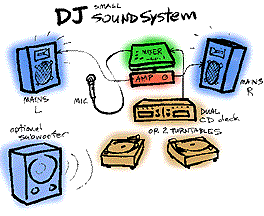 For those of you who aren't Gear Heads, here's a quick
explaination of what equipment makes up a Disc Jockey (DJ) system.
The basic premise of a DJ system is that the operator
can talk to the audience and mix or segue (segWAY) between two
different songs at once, usually crossfading from one song to
the next in order to keep people on the dance floor. Dancers are
easily bored or distracted, so the DJ keeps them tricked into
staying on the dance floor by fading into songs with similar tempos.
Some DJs take their craft to a higher level with improvised scratching,
sampling and mixing of vinyl, but for now we'll look at the average
commercial DJ.
Start with the media players, shown in tan color, which
could be two turntables and/or a dual CD deck. Some DJs use both
CDs and vinyl records. The signal from these feeds into the mixer,
(green) which has sliders for each signal, to regulate volume.
The mixer also has a cross-fader that brings up the volume of
one source while pulling down the volume of the other. The mixer
also has a mic input with seperate volume control. Some mixers
have digital special effects like echo and crazy sound effects
to add flavor to the show.
The audio signal leaves the mixers output and goes
to the inputs of one or more amplifiers. The amp does only one
thing: make the signal loud enough for a big room. Speaker wire
connects the amp to the speakers, which are heavy duty versions
of home stereo speakers. They are built for volume and durability.
The average small DJ setup pushes at least 100 watts
per channel at the Main (left and right) speakers. Some guys push
much more power than that. To get that big chest-thumping sound
, you need an optional subwoofer, powered by its own amp. The
sub uses 15" or 18" woofer speakers to put the BIG bottom
into the room. The addition of the powered sub is the the most
noticeable upgrade you can make. Add more speakers to cover a
bigger room, with more amps as needed.
HINT: put the main speakers up on stands to get them
over 5 feet high. This will cover the crowd better, and you can
turn down the volume, saving your amps from overworking. If all
dancers can see the speaker cones, they will get the full benefit
of your sound system. Keep this "line-of-site" rule
in mind.
See our Teen DJ package here
return
For those of you who aren't Gear Heads, here's a quick
explaination of what equipment makes up a Disc Jockey (DJ) system.
The basic premise of a DJ system is that the operator
can talk to the audience and mix or segue (segWAY) between two
different songs at once, usually crossfading from one song to
the next in order to keep people on the dance floor. Dancers are
easily bored or distracted, so the DJ keeps them tricked into
staying on the dance floor by fading into songs with similar tempos.
Some DJs take their craft to a higher level with improvised scratching,
sampling and mixing of vinyl, but for now we'll look at the average
commercial DJ.
Start with the media players, shown in tan color, which
could be two turntables and/or a dual CD deck. Some DJs use both
CDs and vinyl records. The signal from these feeds into the mixer,
(green) which has sliders for each signal, to regulate volume.
The mixer also has a cross-fader that brings up the volume of
one source while pulling down the volume of the other. The mixer
also has a mic input with seperate volume control. Some mixers
have digital special effects like echo and crazy sound effects
to add flavor to the show.
The audio signal leaves the mixers output and goes
to the inputs of one or more amplifiers. The amp does only one
thing: make the signal loud enough for a big room. Speaker wire
connects the amp to the speakers, which are heavy duty versions
of home stereo speakers. They are built for volume and durability.
The average small DJ setup pushes at least 100 watts
per channel at the Main (left and right) speakers. Some guys push
much more power than that. To get that big chest-thumping sound
, you need an optional subwoofer, powered by its own amp. The
sub uses 15" or 18" woofer speakers to put the BIG bottom
into the room. The addition of the powered sub is the the most
noticeable upgrade you can make. Add more speakers to cover a
bigger room, with more amps as needed.
HINT: put the main speakers up on stands to get them
over 5 feet high. This will cover the crowd better, and you can
turn down the volume, saving your amps from overworking. If all
dancers can see the speaker cones, they will get the full benefit
of your sound system. Keep this "line-of-site" rule
in mind.
See our Teen DJ package here
return

